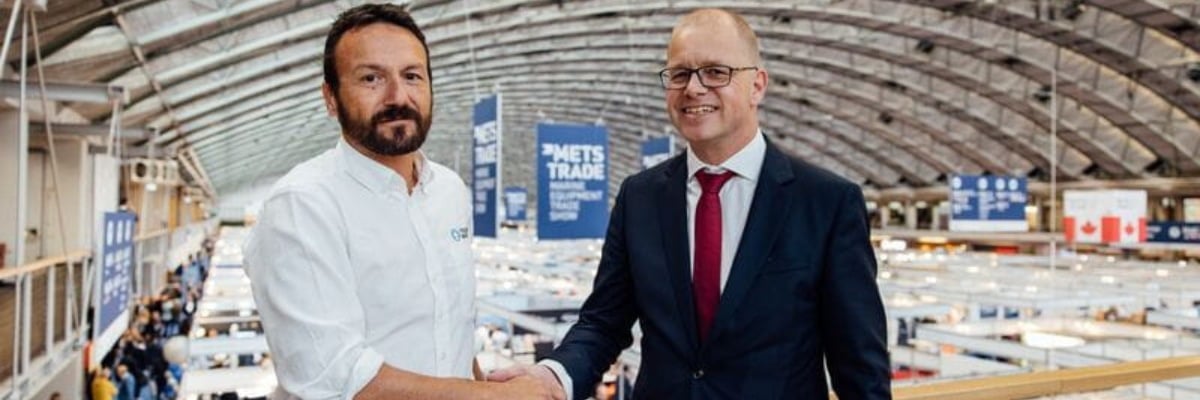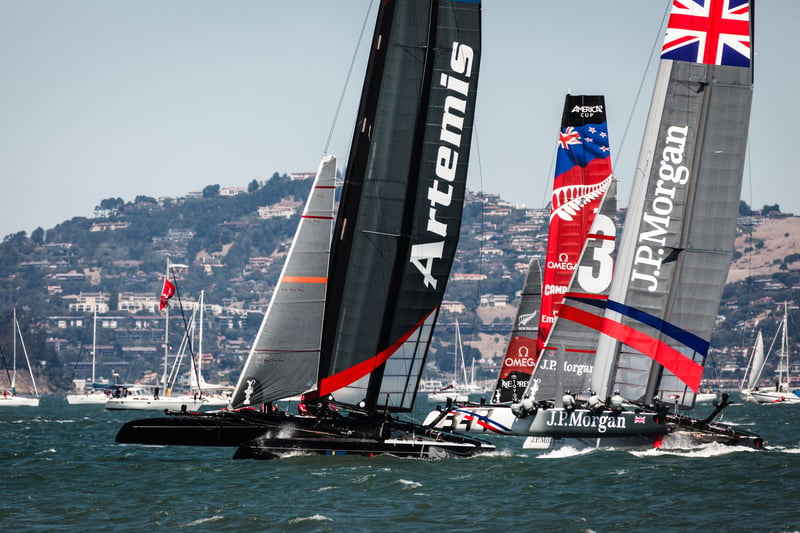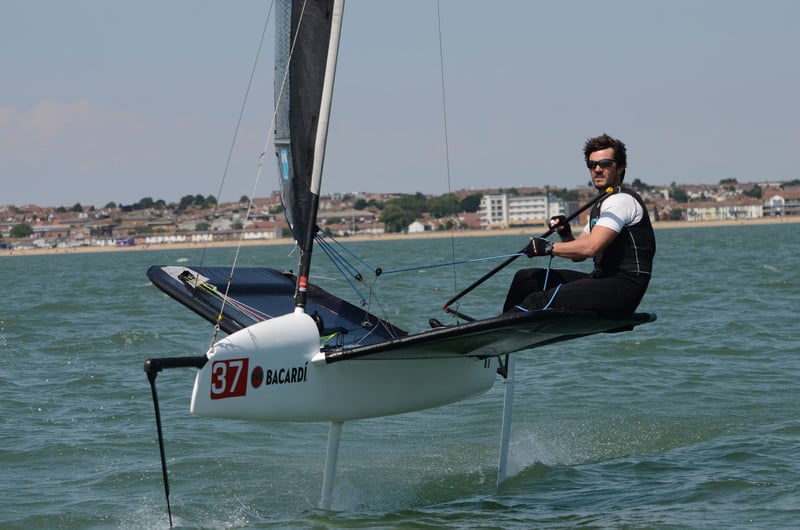
Kim Hollamby speaks with Luca Rizzotti, founder of We Are Foiling, about the widening influence of foiling and the opportunities for industry collaboration at METSTRADE’s Foiling Technology Pavilion and beyond.
It started as a passion. I've been an enthusiastic amateur sailor for most of my life. When living in Australia during the early 2000s, the skipper I was sailing with had a modified 18-foot yacht with foils. I then returned to Italy and joined the very early foiling Moth sailors in 2007.
I became president of the Italian Moth Class, then president of the Worldwide Moth Class, and these roles introduced me to organising events. In 2013, I came up with the idea of the Foiling Week to connect the dots between the 11ft (3.35 m) Moth and the AC72 foiling catamarans at San Francisco in the America’s Cup. It seemed that if a small monohull and a big cat could foil, then everything in between must be foiling soon.
Foiling Week was devised to accelerate the industry. We had many top designers attending to discuss the technology. Many of them only knew each other by name and reputation but had not met in those early years. We held trials so that people could try foiling – that was the start.
This year was the 10th anniversary of Foiling Week, and several other initiatives have grown from it during the past decade.
The Foiling Awards started with seven categories in 2016. It has now expanded to 14 categories over six editions, reflecting how much foiling is gaining traction in different niches such as commercial marine, motorboats, electric foiling boats and foiling toys.
The Foiling Organisation was created to provide us with a proper industry and professional association, with membership encompassing manufacturers of components and boats, designers, and professional sport teams. Our focus is broadening as the technology moves from sport into mainstream. Technology hubs like Artemis, BAR, and MerConcept with François Gabart are taking their yacht racing experiences into products for wider markets and that’s where we need to be now.
We have clustered all this activity under an eco-system called We Are Foiling.

Foiling is becoming more production-oriented than the simple experiments of the past. That is happening because it is easier to understand the products, components, and the technologies needed to make that happen. That's the purpose of launching the Foiling Technology Pavilion at METSTRADE this year. It’s a place to introduce the designers, engineers, simulation teams and product developers who you need to talk to make a full foiling project. Of course, there are more companies out there than the ones you’ll meet on the Pavilion, but each exhibitor represents parts of the equation that are necessary to take boating of all types into foiling.
Foiling will experience the quickest growth in powered boating because it's much easier to introduce than for sailing. It offers the benefit of a smoother ride and represents less of a change for owners of fast motorboats compared to skippers of slower yachts.
Foiling also offers a fast win towards meeting future emission cutting legislation. You can save 50 per cent of energy consumption even with a poorly optimised foil project. That helps of course with electric boating where the range can be extended, and the very high torque of the motor helps get the boat out quicker. However, electrification cannot solve every marine requirement, and so reducing the consumption of other power sources will remain a good opportunity for the industry.
Then we need to look for systems to make foiling easy. Moths have an amazing ability to fly, but they're super challenging – which is the appeal to the sailors that race them. For mass market use that’s no good though – you want simply to press a button and the boat goes foiling without any operator skill. We will certainly need plenty of automation in the system, whether that's the deployment of the foils or the flight controls themselves.
The main components of the supporting system are the flight controls – software that stabilises the boat in three dimensions, whatever the sea state; and the mechatronic – combinations of mechanical, hydraulic, electrical, and electronic components that control the foils.
Flight controls have already reached incredible levels. We see that with racing yachts like the AC40, which is a smaller version of the America’s Cup AC75. You just turn the boat around, and it flies by itself – you don't need to think about it anymore.
We do need to continue to work on the simplicity of systems, ease of maintenance, and not making them appear too cumbersome so that when you open your service bay it doesn’t look like a Star Trek ship. The most important thing though will be reliability and to know you have a system you can count on. Perhaps we’ll take a lesson from aeroplanes and have redundant systems for back up so that if one part fails, we have another to get us home.

The holy grail, in terms of mass and efficiency, will be to try to find a mechanical solution to the flight control system without the need for software, which is achievable but complex. This is like going back to the principles of the Moth, which is all mechanical, but improving it to make it act much faster in response to water and wind conditions.
The issue with the Moth, especially downwind, is that you are so fast over the waves the system doesn't adjust quickly enough, and sometimes it tells the bow to go down when the next wave is coming up – then that doesn't work too well! So, it's just a matter of speed of the system versus sea state.
Of course, the Moth uses a double T-foil system which is already hard to balance, whereas boats using modern mechanical systems will have a wider foiling platform that is more stable. There are people working on solutions for this now with at least one system in production use.
Most systems may still rely on electronic flight control, but it’s likely we’ll also see more developments where mechanical controls manage most of the work, assisted by software for the most dynamically challenging moments.
Well, of course, the Foiling Technology Pavilion in Hall 7 at METSTRADE is a very good place to start. We’ll have opportunities to learn about every aspect of integrating foiling into a boat from many of the leading companies in the sector. We will also have a simulator there, enabling visitors to experience what foiling at high speed is like in the cockpit of an AC40 – it’s the same equipment that the America’s Cup teams are training with.
The Foiling Organization is also opening a base in Genoa for the industry to get together to test and develop foils and controls within a dedicated technology cluster. We already have plans for a second base in the United States.
The potential for optimising foiling through collaboration is proven. Looking at the Moth class again, in 2007 we were achieving 14 knots of upwind speed in 14 knots of wind. In the same conditions now, we do 20–21 knots upwind, a 50 per cent improvement on a boat that was already performing okay.
We will of course need to protect each participant company's intellectual property. But there is opportunity to work together, find what is common and identify what doesn’t need to be developed from scratch each time. We also want to establish common ground on how we determine things like performance numbers and stability, to enable us to work much faster together.
Do you have an innovation, research results or an other interesting topic you would like to share with the leisure marine equipment industry? The METSTRADE website and social media channels are a great platform to showcase your stories! Let us know via metstrade@rai.nl
Make sure you add your latest press releases to your Company Profile in the Exhibitor Portal for free exposure.